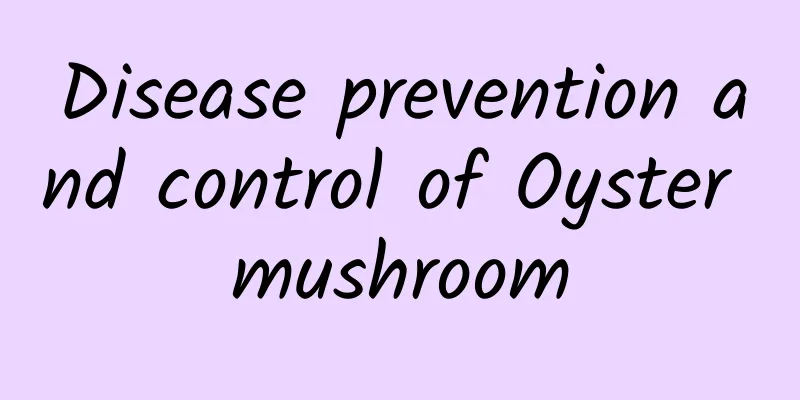Disease prevention and control of Oyster mushroom

|
Some farmers should be familiar with the diseases of Oyster mushroom. Let’s learn about them together. Oyster MushroomIn recent years, the cultivation area of oyster mushrooms has been increasing, but due to poor management and weak disease prevention awareness of growers, the incidence of yellow mushroom disease of oyster mushrooms has been increasing year by year. Some mushroom sheds have not produced mushrooms for a long time after the first wave of mushrooms; some small mushrooms turn yellow before they grow up, and then shrink and die, resulting in the decline of oyster mushroom quality and difficulty in increasing production. To this end, the author has studied the causes of the disease and the comprehensive prevention and control technology, and now reports as follows: Diseases of Oyster Mushroom1. Symptoms. Yellow mushroom disease usually occurs in the cap of young mushrooms or the connection between the stem and the cap of small mushrooms. After the disease occurs, light yellow patches appear on the cap of young mushrooms or the concave part of the cap of small mushrooms. The young mushrooms become sticky, stop growing and die. The small mushrooms grow slowly, lose elasticity, and break at the slightest touch. Then the mushrooms become sticky and shrink, emitting a foul odor. The disease spreads rapidly, causing the surface of the cultivation material to become sticky and stop producing mushrooms. Oyster mushroom diseases 2. Causes of disease. The pathogen of Pleurotus ostreatus yellow mushroom disease is Pseudomonas. ① The fungus is suitable for growing in a humid environment and on a substrate rich in organic matter. It is conducive to the occurrence and growth of the fungus in an environment of high temperature, high humidity and poor ventilation. ② The environment of the old cultivation site has deteriorated and the disinfection is not thorough. ③ There are discarded culture media, defective mushrooms and mushroom stems everywhere in the shed, which is dirty and messy and provides a place for pathogens to live and reproduce. ④ Currently, the cultivation of Oyster mushrooms mainly relies on raw materials or fermented materials. The cultivation materials themselves carry bacteria and cause the occurrence of the disease. ⑤The water or covering materials used contain bacteria. ⑥ The strain has poor disease resistance or the quality of the strain is poor, and the growers’ poor management leads to thin mycelium in the cultivation bag and reduced resistance, which eventually leads to infection with pathogens and disease. 3. Preventive measures.① Choose strains that are adapted to the local environment and have strong disease resistance, such as Heipingwang, Huipingkangbing No. 2, P89 and other strains, which are generally not prone to disease or have a mild disease. Do not plant the same strain in the same field for consecutive years. It is better to change the variety every 2 to 3 years. ② Choose appropriate-age strains that are free of contamination from other bacteria and have thick, white, and robust mycelium. ③ Select high-quality raw and auxiliary materials that are free of mold, rot, insects and pollution. The cultivation materials should be exposed to the sun before use, and fungicides such as carbendazim or carbendazim should be added at 0.1% of the dry material weight. ④ Old sites should not be used year after year. If used, they must be sterilized and insecticidal one month before the cultivation bags are brought into the shed. To kill mold, you can use 500 times diluted carbendazim, 500 times diluted benomyl, etc. To kill bacteria, you can use 200 times diluted bleaching powder, 500 times diluted agricultural streptomycin, 2000 times diluted Wanxiaoling, etc. To kill insects, you can use 500 times diluted DDT, 1000 times diluted cypermethrin, spray the floor, walls and outdoor environment of the shed once a week, 2 to 3 days before the cultivation bags are brought into the shed, and then use sulfur to fumigate for 24 hours. ⑤ Strengthen the management of the cultivation bag during the spawning period to improve the mycelium's disease and weed resistance. During the fruiting period, the temperature and humidity in the greenhouse should be controlled. Too high a temperature is not conducive to the growth of general wide-temperature or low-temperature strains, but provides a suitable temperature environment for various fungi and bacteria; high humidity in the greenhouse is beneficial to the growth of Oyster mushrooms, and is also suitable for the growth of various fungi. ⑥ The mushroom shed should be built in a place with good ventilation and convenient drainage. The ventilation in the shed should be smooth. The vents should be set so that there is flowing wind passing through every surface of the material. There should be no ventilation dead corners. The ventilation time should be adjusted in time according to factors such as temperature, weather, and wind speed. ⑦ When using soil covering cultivation, the covering material must be sterilized and insecticidal. ⑧ Maintain good environmental hygiene in the greenhouse. After picking mushrooms, remove the remaining mushrooms in time, keep the ground clean, and sprinkle lime powder regularly for environmental disinfection. 4. Post-onset treatment.①Once the disease occurs, the diseased mushrooms should be removed immediately, the surface of the material should be cleaned, watering should be stopped, and ventilation should be increased. ② Use 1% bleaching powder to spray the aisles, walls and the surrounding areas of the shed once, and use carbendazim plus agricultural streptomycin diluted at 1:500 to spray the surface of the material, 1 to 2 times a day, and spray for 4 consecutive days to control the spread of the disease. Other drugs such as Huangguqing, Wanxiaoling, Huangbanxiao, Bacteria Killer, and Bacteria Limie can be used alternately according to the standard dosage for prevention and control. |
<<: Tremella and lotus seed soup recipe
Recommend
Abalone Chicken Porridge
I believe that friends who have the conditions ha...
Ingredients and steps for making rock sugar orange
After entering autumn, the weather changes signif...
The benefits of eating wild blueberries
Wild blueberry is a unique fruit in Greater and L...
What are the benefits of drinking apple cider vinegar? Benefits of drinking apple cider vinegar for men
In the eyes of many people, apple cider vinegar i...
Homemade spicy tofu
Speaking of spicy tofu, friends who love spicy fo...
Difference between mustard and kale
In life, mustard greens and kale are both green v...
Peony Porridge
How much do you know about Peony Congee? Please s...
The efficacy and function of Hami jujube
Hami jujube is the most famous local specialty in...
The benefits and nutritional value of lotus root
Lotus root is good for the body when eaten in sum...
How to make shredded pork with green pepper
Ordinary home-cooked dish - shredded pork with gr...
The efficacy and function of litchi peel
When you eat lychees, do you usually just peel th...
How is the Bruker? Bruker reviews and website information
What is Britax? Britax is the top baby stroller an...
What are the benefits of eating big-fruit hawthorn?
Large-fruited hawthorn is the finest among hawtho...
How to peel dried red dates and what are the benefits of eating dried red dates
Dried red dates are the most common blood-enrichi...
What is the U.S. National Library of Medicine like? U.S. National Library of Medicine reviews and website information
What is the website of the United States National ...









